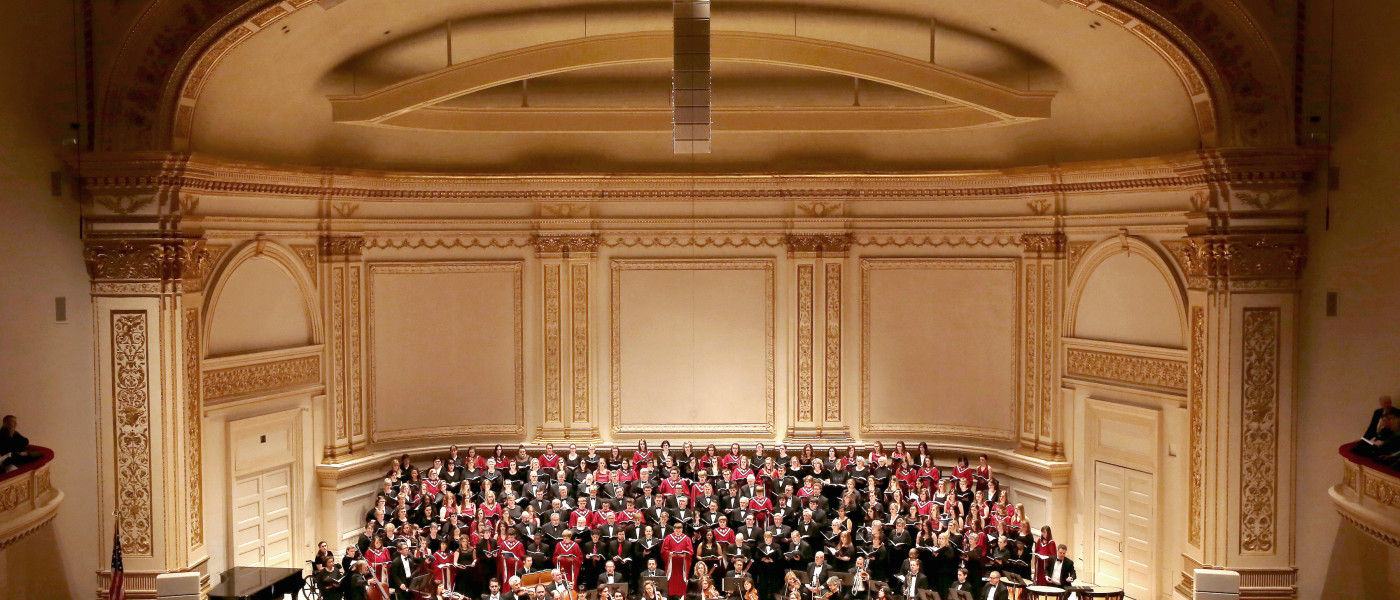Manhattan Concert Productions presents Masterworks Festival Chorus and New York City Chamber Orchestra in Review
Manhattan Concert Productions presents Masterworks Festival Chorus and New York City Chamber Orchestra
Masterworks Festival Chorus
San Jose State University Choraliers
The Phoenix Symphony Chorus
New York City Chamber Orchestra
Jeffrey Benson and Thomas Bookhout, conductors
Layna Chianakis, mezzo-soprano; Jessica Sandidge, soprano; Michael Scarcelle, bass; Marguerite Krull, soprano; Amy Maude Helfer, mezzo-soprano; Nathan Munson, tenor; Paul An, bass
Stern Auditorium at Carnegie Hall, New York, NY
April 27, 2015
Manhattan Concert Productions gives community choruses great opportunities to perform in leading concert halls across America, including Carnegie Hall. Their umbrella reaches from children’s choirs to high-school, collegiate, and community and symphony choruses. These groups then travel to New York and work with the permanent instrumental ensemble known as the New York City Chamber Orchestra. The evening of April 27, 2015, on the main stage of Stern Auditorium at Carnegie Hall, a wonderful range of talent and music was on display.
The program began with the San Jose State University Choraliers, who indeed proved that they have “choral ears,” in fine renditions of Finzi and Elder. Finzi’s music deserves to be much more widely known. Their diction in his My Spirit Sang All Day was exemplary, as was the feeling of tenderness, which followed into Elder’s Willow-Wood, conducted by their own Jeffrey Benson. They were then joined by the extraordinary mezzo-soprano Layna Chianakis in two spirituals. If my pitch-sense isn’t failing me, I could swear she did an effortless high D near the end of This Little Light of Mine, a light which shone brightly indeed.
The main business of the first half was Fauré’s Requiem, Op. 48. This work is comforting, austerely sensuous, and serene in its appeal, unlike the melodramatic/operatic settings of Verdi or Berlioz that emphasize damnation. It was composed in 1888 in memory of Fauré’s recently deceased father. The Requiem, which was modified by Fauré three complete times over many years, has the unusual scoring of omitting the “first violin” sound, thus giving it a darker coloration and symbolizing absence perfectly. Then when the angelic solo violin of concertmaster Robert Zubrycki entered in the Sanctus, the effect was stunning. Again, the conductor was Mr. Benson, from whose group (a massed choir of people from California, Michigan, and New York) I could have used a greater dynamic range, especially in the pianissimi. Their sound was exciting in the louder dynamics, but I missed the great emotional power of a large number of people all singing extremely softy, held-in. I was also sorry to hear some choral diphthongs, especially on the open “e” vowels, which made the church Latin sound so American. The range of instrumental dynamics was not wide enough, from the very first note, a fortissimo D that is supposed to decline to a pianissimo choral entry. This resulted in a “smooth” performance, but one that didn’t maximize contrast. The sound of the electronic organ, the only type Carnegie and other New York halls have at their disposal (with the exception of Alice Tully Hall), was unfortunate and crude, though well-played by the uncredited organist. This is a shame that New York really needs to address if such works are to be presented. The two soloists handled their work admirably, with the soprano Jessica Sandidge wisely not scaling her lovely voice into anything “boy”-sounding in the Pie Jesu, even though the premiere was by a boy soprano. Michael Scarcelle sang the Offertoire and Libera me, Domine with power and intimacy by turns.
After intermission, the Phoenix Symphony Chorus, conducted by Thomas Bookhout, sang a beautiful work by Stephen Paulus, The Pilgrims’ Hymn, excerpted from his opera The Three Hermits, and a less-original but still heartfelt Psalm of Ascension by Dan Forrest. This group, of considerably more mature singers than had been heard in the first half, delivered all the contrasts of text and tone that one could wish for.
They were then joined by choirs from Arizona, New Jersey, and Wisconsin (and apparently some free-lance individuals from New Jersey) for a rousing performance of Haydn’s well-known “Lord Nelson” Mass, originally titled Missa in Angustiis (Mass for Troubled Times). The tempi were moderate, allowing the grandeur of the music to breathe, while articulation, dynamics, and transparency all reflected some of the advances in historically-informed playing that one expects in this repertoire (And again that electronic pseudo-organ). All four soloists were excellent, but I must single (or double) out the soprano Marguerite Krull and the tenor Nathan Munson for the clarity of their tone, its brilliance, and forward placement. Bass Paul An, an accomplished Juilliard graduate, sang well but should nevertheless be advised not to try to sound too “old” or vocally dark before his time, even though he is a bass, because this will eventually wear out the voice. This chorus achieved that magical hush in the final Dona nobis pacem (Grant us peace), a fitting end to a well-done evening of choral music.

